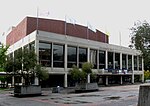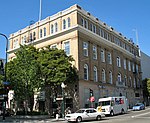Evans Diamond
1933 establishments in CaliforniaBaseball venues in CaliforniaCalifornia Golden Bears baseballCollege baseball venues in the United StatesSports venues completed in 1933 ... and 1 more
Sports venues in Berkeley, California

Evans Diamond at Stu Gordon Stadium is a college baseball park on the campus of the University of California, Berkeley in Berkeley, California. Opened 89 years ago in 1933, it is the home field of the California Golden Bears of the Pac-12 Conference, with a seating capacity of 2,500. Evans Diamond is located in the UC sports complex at the southwest corner of campus, pressed between George C. Edwards Stadium to the west (right field) and Haas Pavilion to the east.
Excerpt from the Wikipedia article Evans Diamond (License: CC BY-SA 3.0, Authors, Images).Evans Diamond
Frank Schlessinger Way, Berkeley
Geographical coordinates (GPS) Address External links Nearby Places Show on map
Geographical coordinates (GPS)
| Latitude | Longitude |
|---|---|
| N 37.869444444444 ° | E -122.26333333333 ° |
Address
Evans Diamond
Frank Schlessinger Way
94704 Berkeley
California, United States
Open on Google Maps








